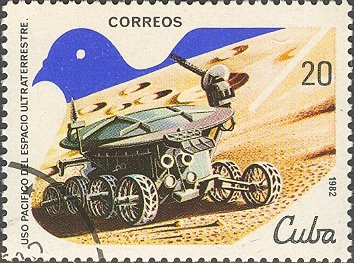Stamp: "Lunokhod-1" (USSR), 1970 (Cuba 1982)
"Lunokhod-1" (USSR), 1970 (Cuba 1982)
12 April (Cuba ) within release Space goes into circulation Stamp "Lunokhod-1" (USSR), 1970 face value 20 Cuban centavo
| Stamp "Lunokhod-1" (USSR), 1970 in catalogues | |
|---|---|
| Michel: | Mi:CU 2653 |
Stamp is horizontal format.
Also in the issue Space:
- Stamp - Spacecraft "Mars-1" (USSR), 1962 face value 1;
- Stamp - Spacecraft "Venera-1" (USSR), 1962 face value 3;
- Stamp - Orbital complex "Salyut" - "Soyuz" face value 6;
- Stamp - "Lunokhod-1" (USSR), 1970 face value 20;
- Stamp - Lander of Spacecraft "Mars-3" (USSR), 1971 face value 30;
- Stamp - Communication Satellite face value 50;
Stamp "Lunokhod-1" (USSR), 1970 it reflects the thematic directions:
A vehicle (from Latin: vehiculum) is a mobile machine that transports people or cargo. Typical vehicles include wagons, bicycles, motor vehicles (motorcycles, trucks, buses), railed vehicles (trains, trams), watercraft (ships, boats), aircraft and spacecraft. Land vehicles are classified broadly by what is used to apply steering and drive forces against the ground: wheeled, tracked, railed or skied. ISO 3833-1977 is the standard, also internationally used in legislation, for road vehicles types, terms and definitions.
The Moon is Earth's only natural satellite. It orbits at an average distance of 384,400 km (238,900 mi), about 30 times the diameter of Earth. Tidal forces between Earth and the Moon have over time synchronized the Moon's orbital period (lunar month) with its rotation period (lunar day) at 29.5 Earth days, causing the same side of the Moon to always face Earth. The Moon's gravitational pull – and to a lesser extent, the Sun's – are the main drivers of Earth's tides.
A spacecraft is a vehicle that is designed to fly and operate in outer space. Spacecraft are used for a variety of purposes, including communications, Earth observation, meteorology, navigation, space colonization, planetary exploration, and transportation of humans and cargo. All spacecraft except single-stage-to-orbit vehicles cannot get into space on their own, and require a launch vehicle (carrier rocket).
Outer space (or simply space) is the expanse that exists beyond Earth's atmosphere and between celestial bodies. It contains ultra-low levels of particle densities, constituting a near-perfect vacuum of predominantly hydrogen and helium plasma, permeated by electromagnetic radiation, cosmic rays, neutrinos, magnetic fields and dust. The baseline temperature of outer space, as set by the background radiation from the Big Bang, is 2.7 kelvins (−270 °C; −455 °F)





